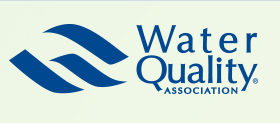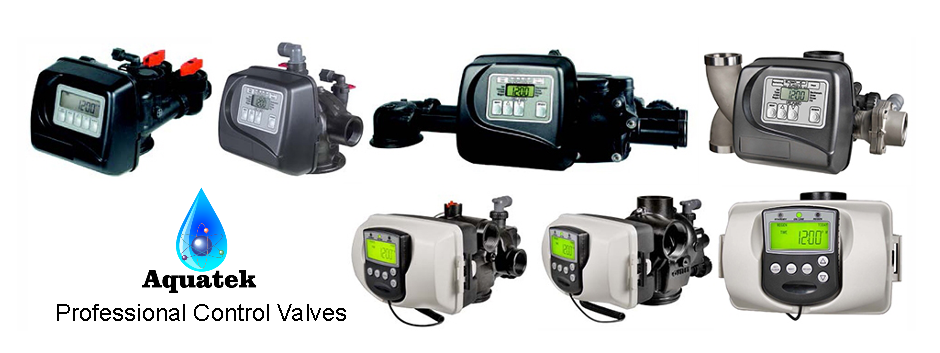How the AquaTek Pro series Hi-Flow water softeners and whole house filters work and save you money:
Hard water passes through the media tank that contains resin beads coated with sodium or potassium ions (depends on salt type used). The calcium and magnesium ions which are part of the total hardness of the incoming water are ex-changed for sodium (or potassium) ions, thus softening the water. When the beads have trapped all the hardness they can hold, they need to be regenerated, the Pro Line control valve charges them by pulling in the brine from the brine tank. As regeneration occurs, calcium and magnesium (hardness) ions are freed from the beads and replaced with sodium or potassium ions making the system ready to soften water again.
All Water softeners have a certain total amount of hardness tthey can remove from the water passing through them. When all of the hardness removing resin beads have dropped it's sodium or potassium ion and has captured the hardness causing ion, the water softener has reached it's capacity. After a water test determines the amount of total hardness in your incoming water supply, we know what capacity water softener you will need.
The average family uses 80 to 100 gallons of water per person, per day. That means a household of five requires 400 to 500 gallons of softened water daily. Always look to the higher amount of water needed because, you don't want to run out of soft water before the water softener regenerates. If your water has a total hardness rating of 30 grains per gallon (gpg), for example, you would need to remove 15,000 grains per day (500 gallons x 30 grains). With a water softener that regenerates every 3 days (time clock valve), your softener's minimum capacity would need to be 45,000 grains (15,000 grains x 3 days).
The total grain capacity would be determined by the size of the mineral tank used on the system. It is always recommended that the total capacity needed, includes a 25% reserve in case the occupants of the household uses more water in a day over the households per person, per day average. If the average daily water usage exceeds the 3 day regeneration setup on a time clock valve, the household will run out of soft water allowing hard water to pass to the house. Adding a 25% reserve capacity to a time clock controlled water softener will help get you through the last hours before regeneration on the third day. Adding 25% to a 45,000 grain capacity water softener (45,000 grains X 25% = 11,250 grains) will give you a water softener that has a capacity of 46,250 grains. Therefore, a 46,250 grain capacity water softener would be our recommendation for your household.
Time clock valves are a good choice for singles or couples that pretty much know how much water they use a day and are regular in their water use. However, if you have a large family and some of the kids haven't caught on to water conservation yet; a metered control valve will be the way to go. A large family's daily water demand can change from day to day making a meter controlled valve a better choice. The meter reads how much water is being used, the electronic control board on the valve will know how many gallons of water has been softened and when it will need to regenerate. On single tank systems, the regeneration generally happens when the household is asleep and the time at which this occurs is adjustable. Multiple tank systems operate differently and are always metered. When the electronic control board determines a tank has reached it's capacity, it automatically switches the household to a clean tank and regenerates the exhausted tank never leaving the household without soft water.
Metered control valves can save you money! The electronic control valve only sets up to regenerate when it needs to which, will save water and up to 40% in salt usage and now that our new solar powered control valves are available, you can also save money on your electric bill.
Which water softener control valve is best for you?
There are 3 basic types of water softener control valves that are used in residential applications to manage the regeneration process. The control valve will manage the frequency of recharging the resin beads that clean the water and flushing the contaminated water out of the system.
Computerized / Metered Control Valve
The most popular of the 3 types, computerized systems regenerate based on actual water usage. The gallons of water used are counted by a meter that in the out flow of the water softener or whole house filter. If you are away on vacation or if you have guests staying, the control will adjust accordingly. Computerized controls are programmed with the grain capacity of the softener or filter, water hardness and how many people are in the home. Since this type of unit only regenerates when capacity in gallons is used, it is the most efficient in salt pellet usage thereby saving you money. Selecting this type of control valve that has solar capabilities will save you even more money!
Timer Controlled control valve
This type of system regenerates based on a time clock (i.e. every 3, 4, or 5 days). The control is set to run at a predetermined time generally while everyone in the house is sleeping, regardless of the actual amount of water that has run through the system. Timer controlled systems tend to be less costly than computerized / metered control valves, however salt usage tends to be higher and there may be times when hard water is delivered due to higher than expected demand.
Manually Controlled control valves
Although rare, there are some applications where a manually controlled system is needed. Manual systems simply use a lever controlled valve that regenerates the system when you want it to. An example of a manual control application is when a permanent drain is not available and a hose is temporarily used to flush the water softener or filter. It’s best to oversize the system in this case so that the system doesn’t need to be regenerated as often.
Consider this important information before buying a water softener!!!
In the market for a water softener? If you are on a well in Florida, the first thing most people on wells need is a water softener due to the hardness of the water here. If you try to save money on the water softener itself, it will cost you more per year to run than if you had bought a more expensive water softener.
A water softener removes hardness and iron from the water flowing through it and must clean itself (regenerate) now and then to remove the impurities it captured from the water. If your water softener is a small, inexpensive unit it will need to regenerate more frequent than a larger, more expensive unit. To save money in the long run, you want a unit large enough to extend the time between regenerations. A water softener uses sodium or potassium chloride (salt) to clean itself.
On average, salt runs about seven dollars per 40 lb. bag if, you go and buy it yourself and lug it home. The more salt you use each year, the more your system will cost you and even more so if, your water softener is an under sized, inexpensive unit. Buying a water softener due to the expense of the unit should be examined very carefully or it will cost you more per year in salt than the unit itself.
This is how a 10" x 54" solar powered water softener can save you money!
40 lb. bag of regular crystal salt = $7.00 on avg.
$7.00 / 40 lbs. = .175 cents per pound
10" x 54" unit uses 20 lbs. avg. salt per regeneration
20 x .175 = $3.50 per regeneration
regeneration interval in days:
every day - cost per year $1277.50 savings $0
every 2 days - cost per year $638.75 Savings $638.75
every 3 days - cost per year $425.84 Savings $851.66
every 4 days - cost per year $319.38 Savings $958.12
every 5 days - cost per year $255.50 Savings $1022.00
every 6 days - cost per year $212.92 Savings $1064.58
Obviously, you want a large enough unit to handle your water conditions and extend the regeneration interval enough to save you a lot of money in salt every year. The initial cost of the unit is a one time thing, while the cost of salt is not and fluctuates. Don't be fooled by the low priced units, they will cost you in the end!
Our units are professional grade and built to handle Florida's water conditions. They have a 5 year warranty and will save you even more money because they are solar powered. Call us today for a free water test and we will show you how to save money with our made in the USA for 56 years and WQA certified systems.



